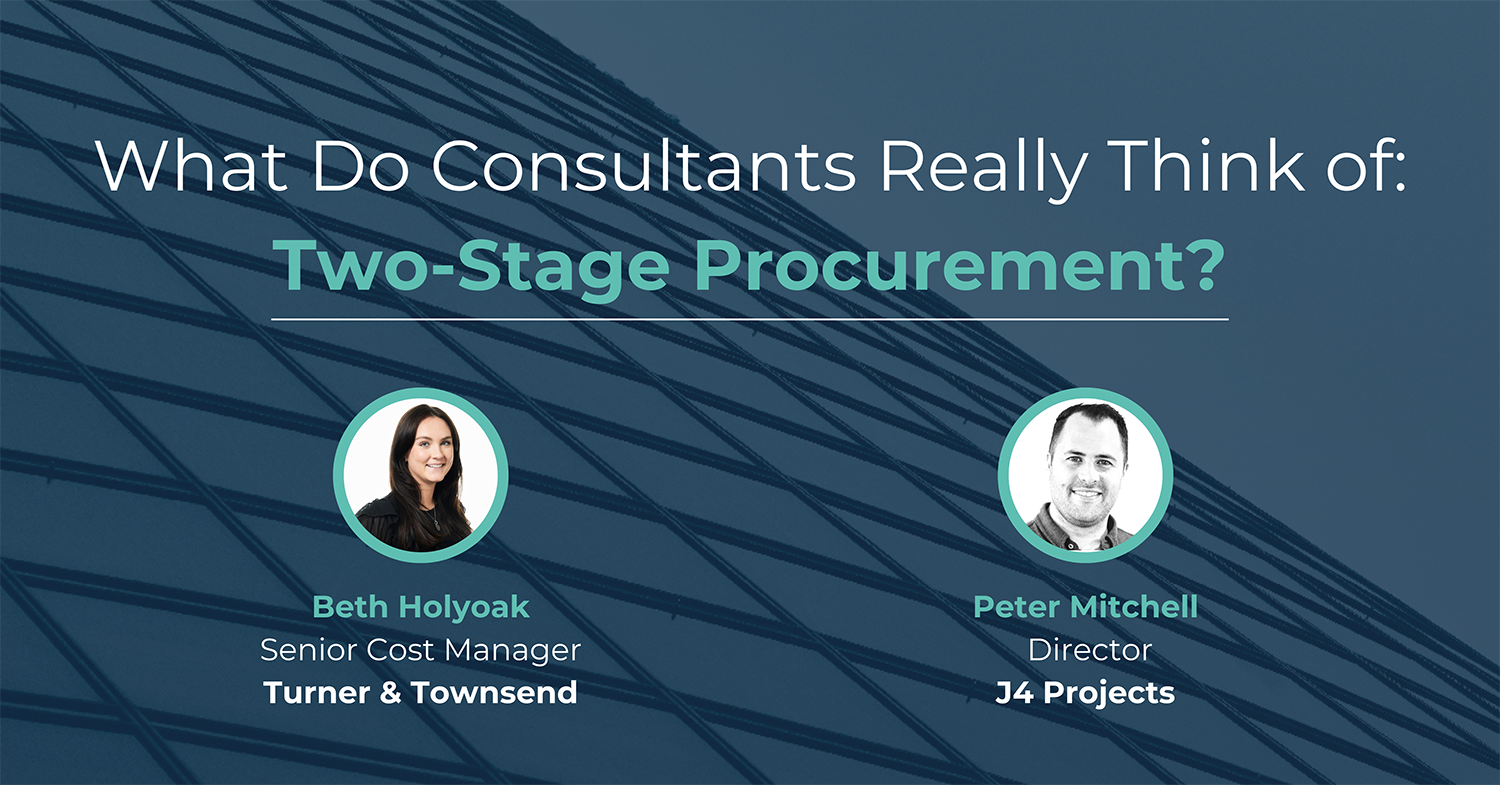Two-stage procurement is a popular procurement route in the construction industry due to its collaborative approach that allows early contractor involvement. This method is believed to enhance project outcomes by leveraging contractor expertise from the initial stages, but what do consultants really think?
In this Ask the Expert series, we explore the insights and experiences of both a Cost Manager and a Project Manager on the advantages and challenges of two-stage procurement. Beth Holyoak, Senior Cost Manager at Turner & Townsend, and Pete Mitchell, Director at J4 Projects, share their thoughts on how early contractor involvement through two-stage procurement can impact cost, design, and overall project success.
From your experience as a consultant, could you explain how involving contractors early in the project enhances collaboration and leads to better project outcomes for clients?
Beth Holyoak, Cost Manager at Turner and Townsend, emphasises that early contractor involvement is crucial for integrating build-ability, design solutions, value engineering opportunities, and project programming from the outset. “By having this early involvement, the design can be developed in collaboration with the contractor to best suit client requirements and embrace innovative building solutions,” she explains.
This early engagement helps align the project’s objectives and expectations, ensuring that all stakeholders are on the same page. Beth adds early contractor engagement can also lead to cost savings, adding that “costs may be saved through the contractors engaging with their supply chains to find alternative design solutions or programme efficiencies.”
Pete Mitchell, Project Manager and Director at J4 Projects, adds that early contractor involvement fosters collaboration and leads to better project outcomes. “If the project team is set up correctly and all pushing in a common direction, it fosters a cooperative environment where all parties are aligned to the same vision and goal,” Pete says.
This unified approach significantly improves planning, risk management, and resource utilisation. He highlights that early contractor input can reveal potential project challenges that might not be apparent during the design phase, thus avoiding last-minute surprises and delays during construction.
Giving our readers the specifics, can you provide examples of how early collaboration directly contributes to a project’s success?
Beth recalls using the two-stage express procurement route on a recent Procure Partnerships Framework project, where early contractor involvement provided significant time savings. “The express route enabled a saving of four weeks in the tender period over the standard route,” she noted.
She goes on to express that using a framework to broach this procurement route can be beneficial during strict timescales, stating “Procure Partnerships Framework offered support throughout the whole process, from an initial call to explore our options, to assisting with site visits and contractor communication.”
Pete shares several examples where early contractor involvement led to successful project outcomes.
For instance, in fast-track summer projects, early coordination of design and planning for construction reduced the overall project duration and ensured timely completion. “For high-value complex refurbishments, early contractor engagement meant more robust and detailed surveys and investigations were completed,” Pete explains.
This integration of insights into the design phase helped avoid delays and streamlined the construction process. By addressing design and logistical challenges early, the project team was able to develop innovative solutions that prevented costly modifications later.
Now we know how collaboration contributes to a project’s success; can you tell our readers some common challenges in construction projects that can be mitigated through early contractor involvement?
Both Beth and Pete agree that design and constructibility issues are common challenges in construction projects that can be mitigated through early contractor involvement. Beth points out that early advice on design solutions, build-ability, and methodology can drive the best value out of the scheme and reduce costs. “The contractor’s input can lead to leaner construction costs and more efficient designs,” she says.
Pete elaborates on this by sharing that practical feedback during the design phase ensures designs are constructible, reducing the need for modifications. “Harnessing the contractor’s experience of construction methodology provides practical feedback during the design phase,” he says, “ensuring that designs are constructible and reducing the need for costly redesigns.”
Additionally, he notes that accurate cost and time estimates are often a challenge, but early contractor involvement can provide more reliable estimates based on current market conditions, experience and historical data. This helps create a more realistic budget and timeline, enhancing the project’s ability to deliver on time and within budget.
Do you have any tips for our readers on how they can mitigate potential issues through early contractor involvement?
Beth and Pete offer several tips for mitigating potential issues through early contractor involvement. Beth emphasises the importance of engaging contractors as early as possible in the process. “A contractor should be engaged as early as possible, typically when designs are at RIBA Stage 2/3,” she advises. This allows the contractor to provide valuable input during the design phase, ensuring that potential issues are identified and addressed early.
Pete stresses the importance of fostering a collaborative environment where clear communication and mutual respect are prioritised. “Transparent communication is key to maximising the benefits of this approach,” he states. He also recommends utilising the contractor’s supply chain networks to ensure the timely procurement of materials and services, reducing the risk of delays and cost escalations due to supply chain disruptions. “Contractors can suggest practical solutions based on their field experience, ensuring that mitigation measures are feasible and effective,” Pete adds.
Two-stage call-off methods encourage early contractor involvement. Can you tell our readers what programme benefits are within a two-stage call-off?
The two-stage call-off method offers several program benefits, primarily by streamlining the tendering process and reducing the time required to appoint a contractor. Beth explains that the first stage focuses on selecting a contractor based on capability and preliminary cost estimates, while the second stage involves refining the scope and costs. “This streamlined approach can be more efficient than a single stage if set up correctly and requires far less detailed submission from the bidders upfront,” she notes. This allows for a quicker timeframe to appoint a contractor and begin the pre-construction phase.
Pete highlights that having the contractor on board as part of the pre-construction team means they can contribute to developing a detailed and realistic project schedule during the first stage, considering potential constraints and bottlenecks. “This helps in setting a more achievable timeline and reduces the risk of schedule slippages,” he says. He adds that early contractor engagement often results in more accurate and reliable project programming, as the contractor can provide their expertise, and insights into potential risks and opportunities from the outset.
To close out the Q&A, can you discuss specific instances where a two-stage call off method has led to significant programme benefits, as well as some final key considerations for our readers?
Beth and Pete share specific instances where the two-stage call-off method has led to significant program benefits. Beth shares her experiences of how the two-stage express method has resulted in significant time savings and programme efficiency, stating “the early involvement of the contractor allowed for faster coordination and decision-making, ultimately saving time and reducing costs.”
Pete shares an example of a high-value complex refurbishment project where early contractor engagement led to more robust and detailed surveys and investigations. “This proactive approach ensured that potential issues were identified and addressed before construction began, avoiding delays and additional costs,” he explains. He also mentions that early contractor involvement in high-value projects allows for better coordination of design and planning, reducing the overall project duration and ensuring timely completion.
Conclusion
In conclusion, both consultants emphasise the significant benefits of two-stage procurement, from enhanced collaboration and accurate cost estimation to improved design and constructability. Their insights reveal that two-stage procurement provides long-term savings and value for money, making it a compelling choice for high-value, or complex construction projects. As Pete puts it, “Experience has shown that the two-stage tender process, if planned and executed effectively with collaboration from all parties, adds a valuable strategy in delivering capital projects.”
For clients considering this approach, both consultants advise engaging contractors early, fostering a collaborative environment, and ensuring transparent communication to ensure this route is successful. Beth adds, “It would also be beneficial for clients to conduct early market engagement with contractors, to understand the level of interest, capability of the market, and preference on procurement routes which may help to determine which route is best as there is no ‘one-size-fits-all’ solution.” Additionally, she stresses the importance of ensuring that the pre-construction scope of services is robust and captures all the employer’s requirements for the end product. By doing so, clients can maximise the benefits of two-stage procurement, leading to more successful project outcomes and greater value for money.



